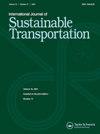可持续的解决方案,降低空调成本和废气排放的重型运输在整个欧洲
IF 3.1
3区 工程技术
Q2 ENVIRONMENTAL STUDIES
International Journal of Sustainable Transportation
Pub Date : 2023-06-01
DOI:10.1080/15568318.2022.2088319
引用次数: 0
摘要
重型卡车的排放量占欧洲公路运输部门二氧化碳排放量的25%,尽管占其车队的约2.5%。全球变暖导致的气温上升将增加重型卡车对空调(AC)的使用,进一步增加其燃料消耗和排放。因此,需要可持续的解决方案来减少影响卡车客舱的热负荷,最大限度地减少对空调的需求,并降低该行业的成本和环境足迹。我们根据欧洲不同地区全年的实际环境条件,评估了欧洲重型运输车队中空调使用的经济和环境影响。对客舱外部涂料和玻璃元件(挡风玻璃和侧窗)光学性能的各种变化进行了潜在的减少。在客舱外表面使用高反射率涂料和低透射率玻璃,整个欧洲每年可减少约1.95亿欧元的燃料成本(即约占欧洲重型车队总燃料成本的0.1%),并将二氧化碳排放量减少到2025年减排目标的1%。这些潜在的减少强调了与运输利益相关者(如工会、汽车制造商、政策制定者和监管机构)接触的重要性,以提高对欧洲运输部门和环境潜在利益的认识,并促进运输车队进行必要的适应。本文章由计算机程序翻译,如有差异,请以英文原文为准。
Sustainable solutions for reducing air-conditioning costs and tailpipe emissions from heavy-duty transportation across Europe
Abstract Heavy-duty trucks emit >25% of the CO2 of the European road transport sector despite representing ≈2.5% of its fleet. Escalating temperatures associated to global warming will increase the use of air-conditioning (AC) in heavy-duty trucks, further raising their fuel consumption and emissions. Thus, sustainable solutions are needed to reduce the thermal loads affecting the truck cabins, to minimize the need for AC and decrease the sector’s costs and environmental footprint. We assessed the economic and environmental impact of AC use in the European heavy-duty transportation fleet, for realistic environmental conditions throughout the year, across the different European regions. Potential reductions were estimated for various changes in the optical properties of the cabin external paints and glazing elements (windshield and side-windows). The use of high-reflectivity paints in the cabin external surfaces and low-transmissivity glazing can reduce fuel costs by ≈€195 million/year across Europe (i.e., ≈0.1% of the total fuel costs of the European heavy-duty fleet), and decrease CO2 emissions by 1% of the reduction target set for 2025. These potential reductions highlight the importance of engaging with transportation stakeholders (e.g., workers unions, vehicle manufacturers, policymakers, and regulating bodies), to raise awareness about the potential benefits for the European transportation sector and the environment, and to promote the necessary adaptation in the transportation fleets.
求助全文
通过发布文献求助,成功后即可免费获取论文全文。
去求助
来源期刊
CiteScore
8.90
自引率
2.60%
发文量
56
期刊介绍:
The International Journal of Sustainable Transportation provides a discussion forum for the exchange of new and innovative ideas on sustainable transportation research in the context of environmental, economical, social, and engineering aspects, as well as current and future interactions of transportation systems and other urban subsystems. The scope includes the examination of overall sustainability of any transportation system, including its infrastructure, vehicle, operation, and maintenance; the integration of social science disciplines, engineering, and information technology with transportation; the understanding of the comparative aspects of different transportation systems from a global perspective; qualitative and quantitative transportation studies; and case studies, surveys, and expository papers in an international or local context. Equal emphasis is placed on the problems of sustainable transportation that are associated with passenger and freight transportation modes in both industrialized and non-industrialized areas. All submitted manuscripts are subject to initial evaluation by the Editors and, if found suitable for further consideration, to peer review by independent, anonymous expert reviewers. All peer review is single-blind. Submissions are made online via ScholarOne Manuscripts.

 求助内容:
求助内容: 应助结果提醒方式:
应助结果提醒方式:


